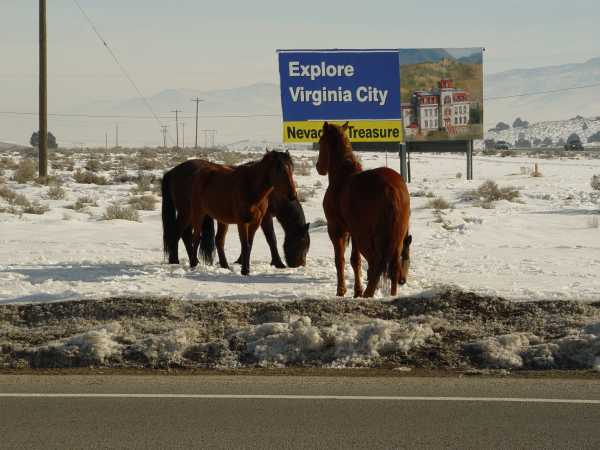|
"Good Intentions" Killing Wild Horses
|
|
Illegal feeding and watering by residents
luring wild horses onto busy Federal highway
Story date: December 17, 2003
|
Part Two
With new development blocking many traditional horse routes and residents who insist on feeding wild horses and luring them into residential areas, there will be more regular occurrences of wild bands crossing the highway during commute hours when visibility is poor.
The state set up a trap to remove these animals and prevent another accident however when State Brand Inspector Mike Holmes was called to the area in the early morning hours of December 19th, he found a Nevada Dept. of Transportation (NDOT) crew struggling with two horses that had recently been struck; a pregnant mare and a foal. The mare was unable to get up and had to be put down. While there he discovered the foal Suffering from a severely broken leg, which Holmes also had euthanize.
According to two sources a local resident then burst upon the scene and literally climbed into the back of the large NDOT truck to see if the animals were "her horses."
"Your horses," Holmes inquired? The resident not only admitted to feeding and watering wild horses, but then started in to berate Holmes for what she accused as an "uncaring attitude."
"I'm in a no-win situation," Holmes later commented. I work all hours to keep these horses out of harm's way, to keep them away from the highway, but people think they are cute and insist on luring them down here.
"Some of these horses are now so tame that they will stand right out in the middle of the roadway. I was asking one lady what she was doing and a 'wild' mare walked right up to me. The mare's foal started nibbling on my jacket."
Occidental resident Arlene Sillings agrees. "For a long time we tried to tell people not to feed and water the horses. As soon as the residents understood, new people would move in and start feeding the horses. They then get on the highway and they disturb people who don't want horses in their yards looking for treats."
Horses eating feed left at the intersection of US-50 and State Route 341

Sherry O'Mahoney, president of the Virginia Range Wildlife Protection Assn. runs a state approved winter feeding program. "We spend a lot of money and do a lot of work to keep the horses back in the hills where they are safe. When people lure the horses down into the valleys it undermines our efforts."
Holmes agrees. "I've watched these bands for years. It isn't unusual for them to come down from the hills north of the highway (US-50) and graze for maybe a day or two, then they would go back up into the hills for water and protection. They pretty much stayed away from the highway. Now they are staying down at the lower elevations and wandering back and forth through the residential areas. We know they are being given water and hay over there."
Willis Lamm is the president of LRTC, a multi-state group that teaches people how to gentle and train wild horses. Lamm added, "It doesn't make sense for the horses on the north side of US-50 to hang around the neighborhoods except for the fact they are being baited by residents. Plus the horses that were killed involved a situation that was completely avoidable. Those horses bed down near the Carson River where there is plenty of water and grass right there yet they're crossing the highway to be in the residential areas at 'feeding time.' Once they are tame, even if relocated into the hills, many will wander back down to take advantage of the 'easy pickings.'"
The frustration of local horse groups is evident. Julie Keller, Vice President of the Wild Horse Protection League lamented, "We've tried everything we could to protect these horses. We got the state to install the Strieter reflectors. We've tried to educate the public, but sometimes it seems so hopeless."
Shirley Allen, Adoption Program Manager for LRTC, pointed out, "Sometimes the state corrals are overflowing with horses. Too many of them needn't be there except that people lured them into populated areas and caused them to become a problem."
Olivia Fiamengo of the Comstock Wild Horse and Mining Museum in Virginia City added, "I've tried to fight this battle for ten years. I even got permission from the county to put up signs warning that it is illegal to feed or harass wild horses, but with so many new people moving into the area it's an impossible job to stop it. When folks come in and ask what they can do, I tell them contact the state approved adoption groups and help find some homes for these horses. If people keep luring the horses down near the highways the state is going to keep picking them up and they're going to have to be placed with adopters. Until we can set up some kind of a permanent sanctuary, adoption is about the only humane option we have."
Lamm concluded, "A lot of people want to preserve the presence of these wild horses. That's not likely to happen, however, unless everyone lets the wild horses stay wild."
Then the story gets even more complicated...
While being transported to Foster Care, one of the survivors, a very pregnant mare, was kicked and fatally injured by another mare. The volunteers managed to save the kicked mare's unborn foal. Please click
here to read this remarkable story.
2006 Update: Phantom trapped and permanently removed. Click here for the story.

| 
